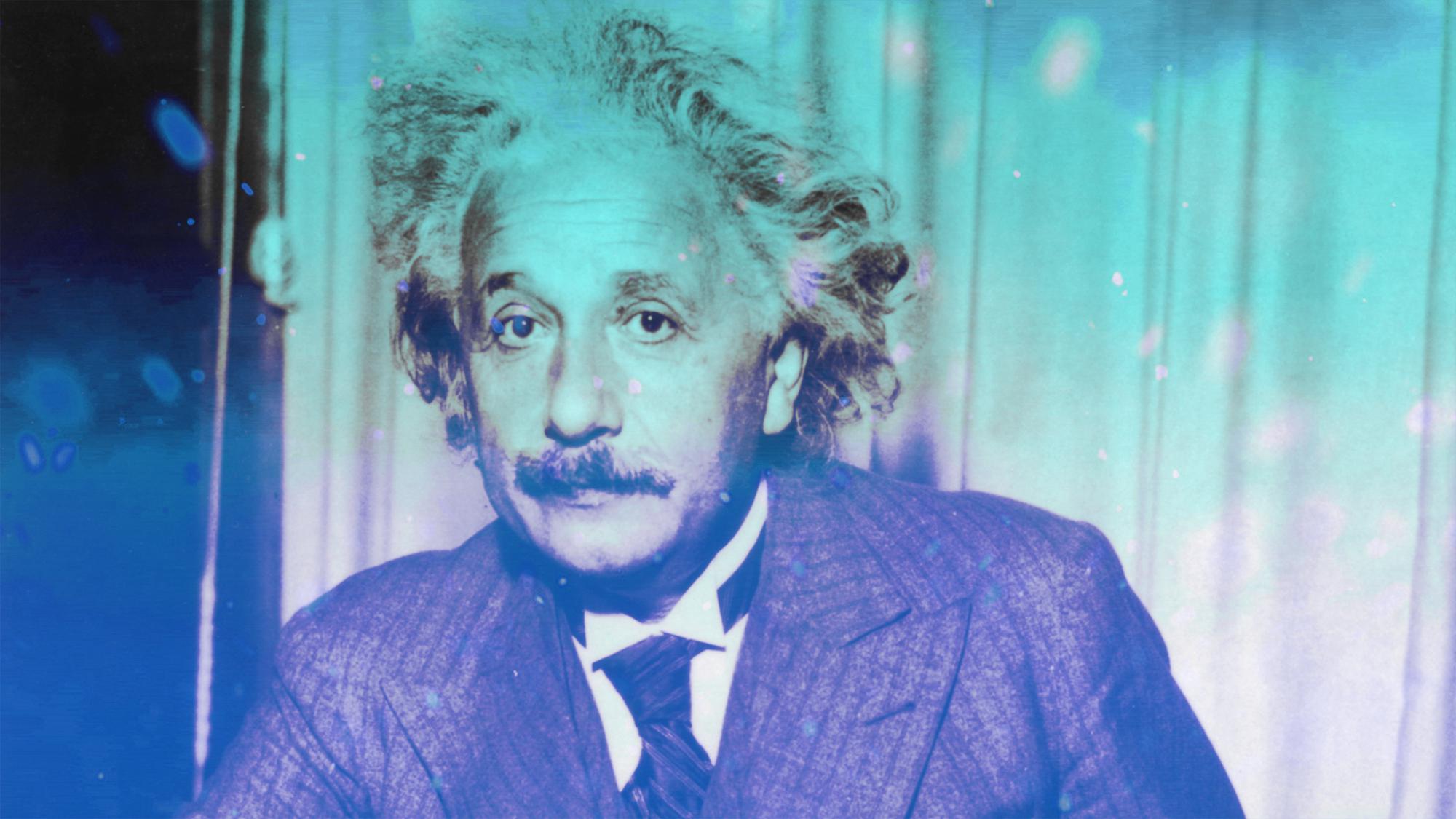MICHELLE THALLER: Albert Einstein was incredibly brilliant and he revolutionized our understanding of the universe.
MICHIO KAKU: People ask the question what has Einstein done for me lately. And the answer is everything. Everything we see around us – the electronics, the satellites, the atom smashers, all of that in some sense could be traced back to the work of Albert Einstein. In fact, many of the crumbs, the crumbs from his table, have gone on to win Nobel prizes for physicists even today.
THALLER: Einstein, right. I just say that word and all of a sudden you're thinking about sort of crazy white hair and a mustache, somebody who is brilliant. Those wonderful knowing eyes with lots of smile lines around them. Everybody knows who Einstein is and people understand that he was a very famous scientist. But I think that people often don't grasp the true depth and the profound nature of the things that Einstein introduced to us.
DAVID BODANIS: His sister thought he was a genius. His father thought he was a genius. But he was stuck in the patent office in Bern, Switzerland and nobody else thought he was a genius at all. He had mouthed off to his professors at university. He didn't get any good job. His department of theoretical physics was the top drawer of his desk and he had slammed it closed. But then, and he had tried all sorts of things. He was about 25-26. He had tried lots of ideas while he was stuck at the patent office. Nothing had really come together and then suddenly in the spring of 1905, it was like a storm burst in his head. He poured out one paper after another. About four of them were worthy of the Nobel prize and the final two were special relativity and E = mc2.
FREEMAN DYSON: He had just this wonderful gift of talking to the public and in addition, of course, he had a turbulent family life and he was in many ways a selfish and unpleasant character. But on the other hand, he was wonderful with children and so on. I mean there were all sorts of – he had wonderful qualities. And those things I think the public rightly appreciated.
BODANIS: Einstein once said he wasn't smarter than other people, but he said I have the persistence of a mule. And he was really honest about it. When he was a little kid he'd make card castles. He'd make layer after layer after layer of card castles and if they blew down well, he'd take a deep breath and build it up again. All through his early 20s he was happily married at the beginning to a really hot young Serbian physician student. The only woman in his class at the Polytechnic Conservatory. And they had great dreams of maybe becoming professors together. But reality got in the way. He was stuck at the patent office and until 1905 when he was 25-26 he couldn't get any fresh ideas. And he and his wife they began slowly to drift apart. They didn't have money for childcare. She was stuck at home taking care of the kids. She couldn't really participate in his work.
THALLER: Einstein was a professor. He actually taught a lot at the University of Bern and also in Berlin and then eventually came to Princeton. He was very much a product of the time and the science that was going on. There were brilliant people at this time. Science was changing in so many different ways, and for a lot of things Einstein found himself in the right place at the right time to see two different things going on and say aha, those things actually go together. And to me that really was some of the real brilliance of Einstein was that he became a bridge between many, many different subject matters.
BODANIS: In 1905 he did have this epiphany or series of epiphanies. He had great, great achievements and he thought he was home clear. But nothing happened. The great professors in Germany, one or two of them monitored his work but he couldn't get a job. He applied at one point to teach at a high school in Switzerland and he submitted as a justification for teaching science in high school this theory of relativity, E = mc2, and a few other things like that. He was rejected. This was Switzerland. He hadn't done the proper forms. They weren't properly typed and he stayed in the patent office. In 1920 in Germany the opera house in Berlin was taken over by an anti-Einstein rally. There were swastikas in the front hall. This wasn't Aryan science. This was Jewish science. It had to be wrong. And then horribly, in 1933, his books were burned on the streets in Germany. And they weren't just burned by uneducated mobs in the middle of nowhere. The greatest university the world had known was Gottingen in Germany at the time and the students there so caught up in what was happening that they dragged Einstein's books, and books of other people. and they burned them in huge piles right in the center in Berlin and in Gottingen and in other places. Luckily by then, Einstein was out of the country. Some of the major newspapers and magazines were charging him with, they said they had to kill him. It's a variation—They didn't just say lock him up. They said the next stage. You start with one stage, you go to the next. Because he was famous, he managed to get to America. He lived safely in Princeton, New Jersey after that.
THALLER: And he wasn't working alone. Some of the major parts of his theory, for example, the special theory of relativity that deals with how time slows down when you go close to the speed of light, had largely been formalized and set up before by people like Lorentz. And even parts of general relativity, his idea about gravitation and the curvature of space had been done by people like Lemaitre and others.
GEORGE MUSSER: Science is a deeply collaborative enterprise and I've always been struck when I see physicists in action how much they are teaching one another. This is a social enterprise and they kind of go back and forth between the individual sitting, struggling against the brick wall, banging their head against it trying to make sense of reality and the collaborative social side of things. So one thing that's crucial to that is that all scientists have to gather around them some kind of friend group. So science probably more than a lot of jobs really depends on strong personal friendships among people. Sometimes this idea isn't located in either person's head, but it's kind of floating in the space between them and each person is kind of contributing to it. The idea is growing and growing and growing. Einstein for one loved it. He reveled in this kind of intellectual play. So he had a series of very famous encounters with Niels Bohr at a series of meetings in the '20s and, well really in the '20s. In the '30s things kind of all fell apart for Europe in general but certainly for the German science community. So in the '20s and the teens he went to these conferences and would encounter these other scientists who just didn't accept what he was saying. And they would go off usually off the record and these had to be reconstructed by historians, had these intense debates over breakfast, over wine, over just walking down the street.
THALLER: Einstein was absolutely brilliant at seeing that different theories that people were working on could come together into a wonderful coherent whole. Even he admitted he wasn't particularly great at the mathematics and he had other people that assisted him with actually formalizing the mathematics of how gravity could work. So Albert Einstein himself would have said that he was brilliant in collaboration, that he actually pulled lots of things together. He wasn't just a lone person pulling stuff out of his head from first principles just by magic.
MUSSER: And there were some famous episodes where Einstein, for instance, tried to question the Heisenberg uncertainty principle and he would come up with aha, here's a way to get around the Heisenberg uncertainty principle. And Niels Bohr would stay up all night and come back the next day and say well nope, that won't work. 'Ah, here's another one,' said Einstein. Niels Bohr would go back and figure out a way it didn't work. And they would go back and forth. And what's funny about this in a way is that Einstein really never doubted the uncertainty principle. He accepted it. He accepted it kind of at least maybe not from the very beginning but once the mathematics was worked out he accepted it. And yet he kind of poked and prodded at it because he thought such a strange feature of reality that it's uncertain, it's indeterministic, should have some deeper meaning and he tried to poke that principle and explore it from different sides to ascertain the meaning.
THALLER: It amazes me that he was one of the people when he was doing his doctoral dissertation figured out the size and speed of a molecule in the air all around you. People didn't realize at the time when Einstein was a younger student in college that air was made of molecules. Can you imagine when they realized that's what air really was? Einstein was a major figure in that.
BODANIS: But he had another idea, a more powerful idea which came together in 1915 when he was in his mid-30s, the middle of World War I, and it's called general relativity. And it's a notion of explaining how all of space and time, and all of matter, and everything's organized. And what's amazing is that instead of it being a law and complicated thing he got it down to two little symbols and this was extraordinary. He thought who had created a universe where all the complexity we see, the spinning of the Earth around the sun, how the galaxy moves if it moves at all, that all this could be explained in terms of two simple symbols. And he thought this was fabulous. And then he looked at his symbols and he realized hmm, they predicted that the universe was expanding. He asked his astronomer friends in 1917-1918 is the universe, in fact, expanding. And they said no, it's static. They thought at that time the universe was just the Milky Way Galaxy, a whole bunch of stars floating there in space and beyond there was just an empty void, angry magnetic fields full of nothing. And Einstein thought are you sure? And they said well, that's kind of what the universe is like. So he had to change that beautiful simple equation and had to put in an extra term which he symbolized by the lambda. About ten years later, 1929, Edwin Hubble in California and other people said 'Oy, were we wrong.' They probably didn't say the word oy. 'Were we wrong,' they said, 'The universe is expanding after all.' And Einstein thought the good news is I get to take away the lambda, that extra term. I can to back to that beautiful simple clear thing I discovered back in 1915 in general relativity. And that's okay. That's an allowable mistake. I don't think that's his greatest mistake. The great mistake came after that. He drew a psychological conclusion. He concluded that he was wrong to have listened to experimental evidence because he believed that the universe should be crisp and clear and exact. From now on if he had those beliefs and experimental evidence came up that contradicted it he could ignore it. Remember, he would have been right. He would have been right to ignore all the evidence that the astronomers thought about the shape of the universe. They were wrong for ten years. That's why he said 'God does not play dice with the universe.' And his good friend Niels Bohr said 'Einstein, stop telling God what to do.'






